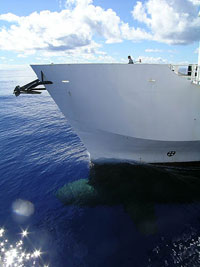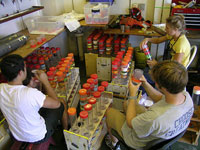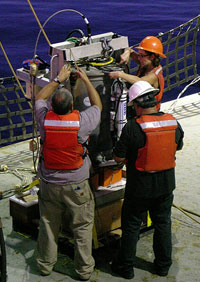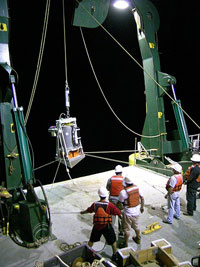- C-MORE Home
- What is Microbial Oceanography?
- What is C-MORE?
- Research
- • Research Cruises
- » BioLINCS
- Home
- Cruise Participants
- Instruments Used
on the Cruise - Nitrogen Cycling
- Marine Microbes
- Cruise Blog
- Data Archive
- Education & Outreach
- People
- Publications
- Image Library
- Contact Us
| |||||||||||||||||||||||||||||||||||
BioLINCS Cruise Blog
Wednesday, September 7, 2011
|
Looking from one of the twin hulls of the Kilo Moana toward the other, you can see through the water the bulbous pontoon that helps make this ship so stable. You can also see how smooth and glassy the ocean has been for the last day and a half. |
|
Several times this morning we passed through what looked like streaks of dust or debris on the sea surface. We don’t know for sure, but we believe these streaks are formed by are a kind of filamentous bacteria called Trichodesmium, which we will be studying during our cruise. |
|
I got to help out with our first CTD cast of the cruise. It takes perhaps five or six people and a large crane to lower this array of water-collection bottles and instruments 500 meters down into the ocean and then lift it back up to the surface again. |
|
As we steamed northward this morning, Ariel Rabines and Ben Rubin helped Tara Clemente (at right) prepare dozens and dozens of collection bottles for the “Lagrangian sediment traps” that we will be deploying later this week. |
|
Gene Massion, Roman Marin III, and Julie Robidart (left to right) prepare the Environmental Sample Processor (ESP) for its first free-drifting deployment in the middle of the Pacific Ocean. |
|
It took over dozens of people and months of preparation, but the drifting Environmental Sample Processor (ESP) was successfully deployed around 8 PM this evening. You can just see the large yellow surface buoy that supports the ESP floating behind the ship on the right side of this photo. |
I awoke this morning to bright tropical sunshine sneaking between the curtains in my stateroom. Outside, the sea was glass smooth and very blue. From my window I could see the wake of the ship as a series of undulating azure waves flowing out behind us. We’d been steaming north at about 12 knots throughout the night, but aside from the view out my window and the distant rumble of the engines, it was hard to tell that we were moving at all.
After breakfast, several of us walked out to the bow of the ship to look at the ocean. Picturesque trade-wind clouds decorated the horizon on all sides. No sign of land, of course. Looking down, the water was so transparent that we could clearly see the huge, bulbous pontoon-shaped hulls of the ship surging through the water. With their stabilizing fins, the pontoons reminded me of two giant sharks.
Watching the glassy water slide by, I noticed that its mirror-like surface was blemished with specks of dust or bits of what looked like feathers. Every now and then we would see a piece of trash float by. But this dusty stuff definitely wasn’t plastic. It seemed to form patchy streaks, especially where the sea surface was particularly smooth.
It turns out that this “fluff” was probably one of the organisms that we will be studying on this cruise—a type of cyanobacteria in the genus Trichodesmium. (Cyanobacteria were formerly known as “blue-green algae,” but these days they are classed as bacteria). Trichodesmium is the only organism we will be studying that is visible to the naked eye. It’s a colonial organism that forms long, thin hair-like strands. Sometimes these strands become tangled together to form clumps that are visible to the naked eye. When winds are light (as they certainly were this morning) these clumps often float at the sea surface, giving Trichodesmium its common name, “sea sawdust.”
The researchers on this cruise are interested in Trichodesmium because it is one of the main organisms that can take up nitrogen gas from the surface waters of the open ocean. Along with a few other types of bacteria, Trichodesmium converts the nitrogen gas into ammonium, which functions as a “fertilizer” for bacteria and algae that support most other life in the open ocean. This process is known as “nitrogen fixation.”
Nitrogen fixation is vitally important for all life in the open ocean. Because it forms large colonies, Trichodesmium is the most obvious of these, and has been known for decades. However, using cutting-edge molecular (gene-based) techniques, in the last few years, researchers have begun to identify other types of nitrogen-fixing microbes in the ocean, most of which seem to be bacteria of one kind or another. Some of the researchers on this cruise will be collecting samples of seawater and studying the genes of bacteria in the seawater to figure out whether the bacteria are able to “fix” nitrogen. More specifically, they are looking for genes that allow the bacteria to produce nitrogenase, an enzyme that is used to convert nitrogen gas into ammonium.
Some of these analyses will be performed in laboratories on board the ship. Other analyses will be performed in the open ocean (or in situ, as scientists like to say) by an amazing instrument called the Environmental Sample Processor (ESP). Developed at the Monterey Bay Aquarium Research Institute, this instrument is essentially a robotic molecular biology laboratory, packed into a waterproof housing about the size of a 55-gallon drum. Inside are tiny pumps, syringes, heaters, filters, chemical reagents, and robotic arms for moving samples from one processing area to another.
After setting up the ESP up in the laboratory, researchers place it in the water, on a mooring, or (as in this cruise) suspended from a free-floating buoy. Although the researchers can communicate with the ESP from shore, it works on its own, sucking in water samples, extracting the DNA or other genetic material from microbes in the water, then analyzing that DNA to determine what organisms are present. The ESP can also determine if certain types of genes, such as the genes necessary for nitrogen fixation, are present.
We were scheduled to deploy the drifting ESP today. But first we had to figure out the best place to put it. Throughout the morning we headed northward across the open Pacific. We headed northward looking for an area that where the currents were relatively strong. We wanted strong currents so that the ESP would move around with the currents, not just stay in one place for 10 days. This way we could sample seawater and organisms from different parts of the ocean.
We traveled northward until a little after noon, but, like the wind, the currents were barely moving. During our trip north, we had been measuring the currents, and had observed an area of relatively strong currents on our way up. So we headed back south, and ended up (as far as I can tell) about 30 miles south of the location shown on the BioLINCS cruise home page.
During the passage north and south, researchers on board the ship worked on instruments that we will be deploying over the next couple of days, and set up their labs to process the seawater that we will be collecting using the CTD array. Around 3 PM, soon after arriving at our study site, we took our first “CTD cast,” collecting water from eight different depths, ranging from 500 meters to 5 meters below the surface. Several of us were trained to help with these CTD casts. We be performing three casts a day, so we need lots of people for the job.
Finally, well after dinner time, we began preparing to deploy the Environmental Sample Processor. Everyone knew it was going to be a tricky operation. It involved lifting a massive 2.5-meter-diameter buoy with one crane, placing it in the water, then lifting the ESP (which is attached to the buoy by a long cable) using the ship’s “A-frame,” and lowering the ESP down to 25 meters below the surface—all without tangling or putting too much tension on the cable. We had three scientists, several marine technicians, and probably 8 or 10 of ship’s crew working on the project, as well as most of the researchers as onlookers.
Like most delicate operations, most of the time was spent in preparation. As the sunset sky faded to pale blue and lavender, the crew checked all their lifting gear and the ESP team made last minute adjustments to the instrument. Finally, well after dark, the buoy and instrument slide gently into the water. We all breathed a sigh of relief as we watched the bright yellow buoy float off behind the stern of the ship and into the darkness.
As I write this, around ten in the evening, Roman Marin III and Gene Massion, the ESP engineers, have successfully made radio contact with the ESP. They have assured me that it appears to be working well and is already taking its first sample. So the first (and arguably most complicated) of our instruments is now drifting around the open Pacific Ocean. Over the next few days, we’ll be releasing several more complicated instruments to drift around the ocean. In my coming blog entries I’ll describe each of the instruments as they are deployed. After that, we’ll move on to our next challenge—getting all these peripatetic instruments back on board the ship…
[ Top of Page ]









